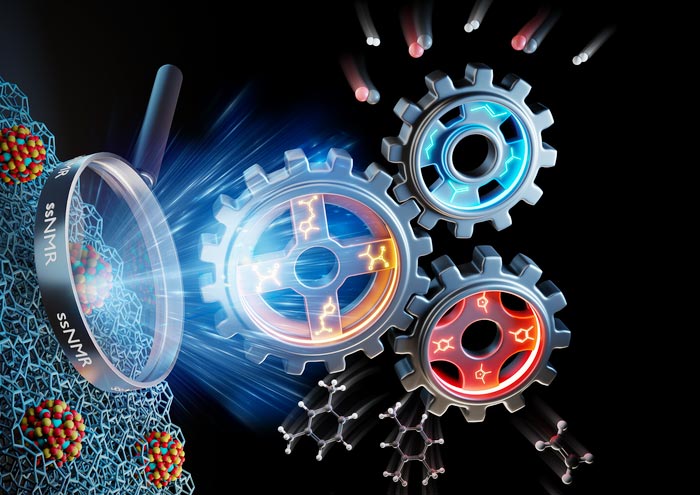Researchers reveal oxygenate-based routes in syngas conversion

Solid-state NMR studies reveal that the oxygenate-based routes regulate syngas conversion over OXZEO bifunctional catalysts
Credit: DICP
… over oxide-zeolite bifunctional catalysts.
A research team led by Prof. HOU Guangjin and Prof. BAO Xinhe from the Dalian Institute of Chemical Physics (DICP) of the Chinese Academy of Sciences (CAS) has revealed the oxygenate-based routes in syngas conversion over oxide–zeolite (OXZEO) bifunctional catalysts by solid-state Nuclear Magnetic Resonance (NMR).
This study was published in Nature Catalysis on June 23.
OXZEO catalysis was proposed in 2016 by Prof. BAO Xinhe and Prof. PAN Xiulian from DICP. It provides a platform for the efficient utilization of coal and other carbon resources. However, the reaction mechanism in OXZEO catalysis still remains unclear.
In this study, the researchers chose the syngas conversion over the ZnAlOx/H-ZSM-5 bifunctional catalyst as a model system to highlight the mechanistic difference in the OXZEO-based syngas direct conversion. ZnAlOx is a typical metal oxide for syngas to methanol process while H-ZSM-5 is a typical zeolite for methanol to hydrocarbons (MTH) reaction.
They used the quasi-in situ solid-state NMR (ssNMR)-Gas Chromatography (GC) analysis strategy to reveal the dynamic evolution of abundant critical and/or transient intermediates, including multi-carbon carboxylates, alkoxyls, acid-bounded methyl-cyclopentenones, and methyl-cyclopentenyl carbocations, from the very early induction period to the steady-state conversion under high-pressure flow-reaction conditions.
Oxygenate-based routes were proved to be contributed to the outlet olefins and aromatics, where the feed, i.e., CO and H2, was also a vigorous participant in these secondary reactions. In addition to the ZnAlOx/H-ZSM-5 catalyst, the researchers also discovered that the key intermediates exist in multiple OXZEO catalysts, proving the universality of oxygenate-based routes in OXZEO-based syngas conversion.
“Our findings provide new insights into the reaction mechanism of syngas conversion on bifunctional catalysts, and may also help to better understand the mechanism of CO2 and biomass conversion,” said Prof. HOU.
This work was supported by the National Key R&D Programs of China, the National Natural Science Foundation of China, the Liaoning Revitalization Talents Programs, the China National Postdoctoral Programs for Innovative Talents, and the China Postdoctoral Science Foundation.
Journal: Nature Catalysis
DOI: 10.1038/s41929-022-00806-2
Method of Research: Commentary/editorial
Subject of Research: Not applicable
Media Contact
Jean Wang
Dalian Institute of Chemical Physics, Chinese Academy Sciences
wangyj@dicp.ac.cn
Office: 41182464221
All latest news from the category: Life Sciences and Chemistry
Articles and reports from the Life Sciences and chemistry area deal with applied and basic research into modern biology, chemistry and human medicine.
Valuable information can be found on a range of life sciences fields including bacteriology, biochemistry, bionics, bioinformatics, biophysics, biotechnology, genetics, geobotany, human biology, marine biology, microbiology, molecular biology, cellular biology, zoology, bioinorganic chemistry, microchemistry and environmental chemistry.
Newest articles

Innovative 3D printed scaffolds offer new hope for bone healing
Researchers at the Institute for Bioengineering of Catalonia have developed novel 3D printed PLA-CaP scaffolds that promote blood vessel formation, ensuring better healing and regeneration of bone tissue. Bone is…

The surprising role of gut infection in Alzheimer’s disease
ASU- and Banner Alzheimer’s Institute-led study implicates link between a common virus and the disease, which travels from the gut to the brain and may be a target for antiviral…

Molecular gardening: New enzymes discovered for protein modification pruning
How deubiquitinases USP53 and USP54 cleave long polyubiquitin chains and how the former is linked to liver disease in children. Deubiquitinases (DUBs) are enzymes used by cells to trim protein…



